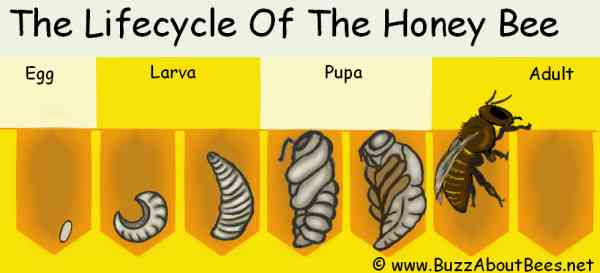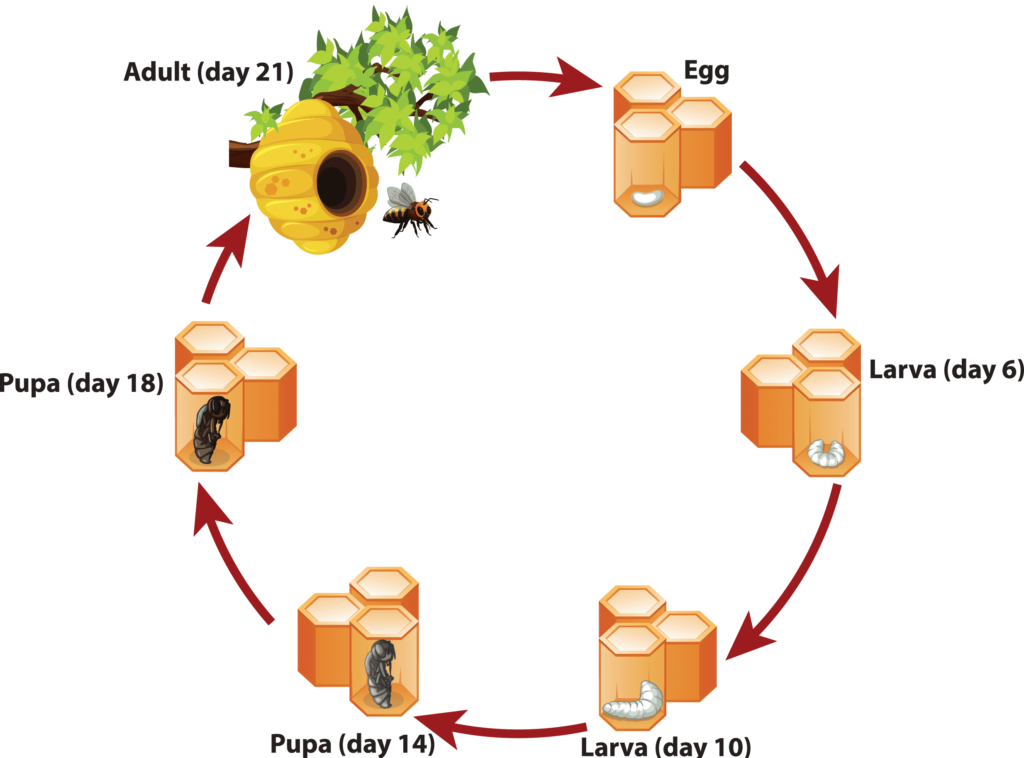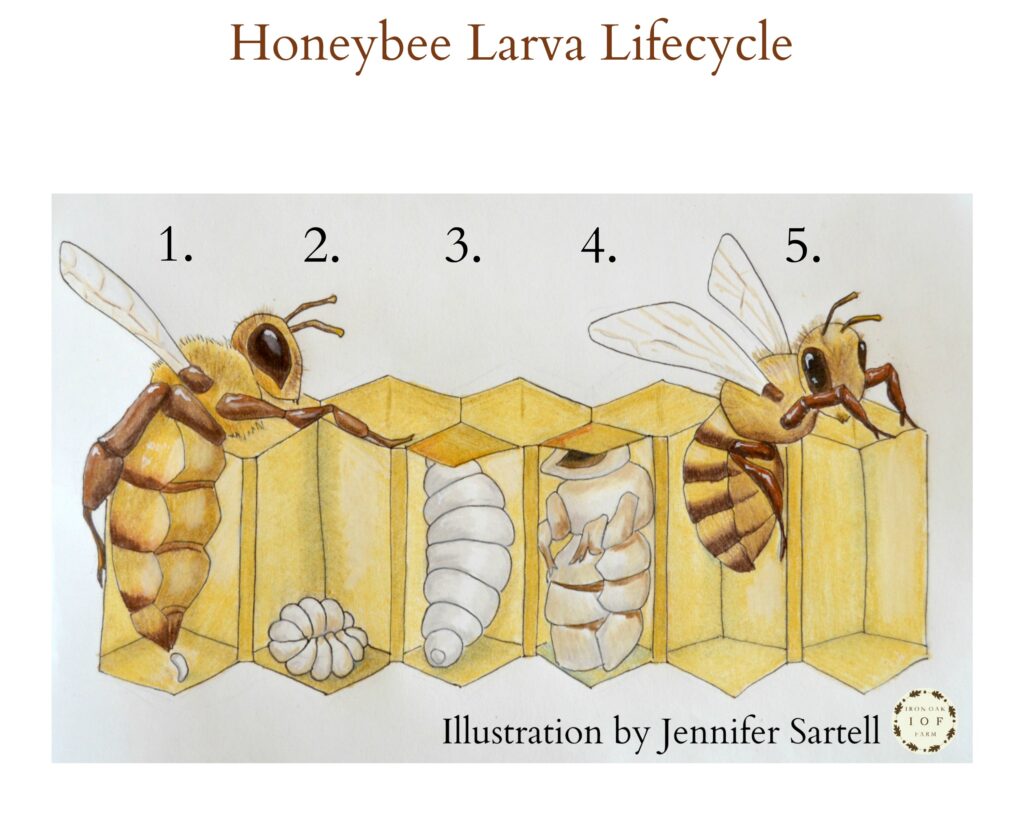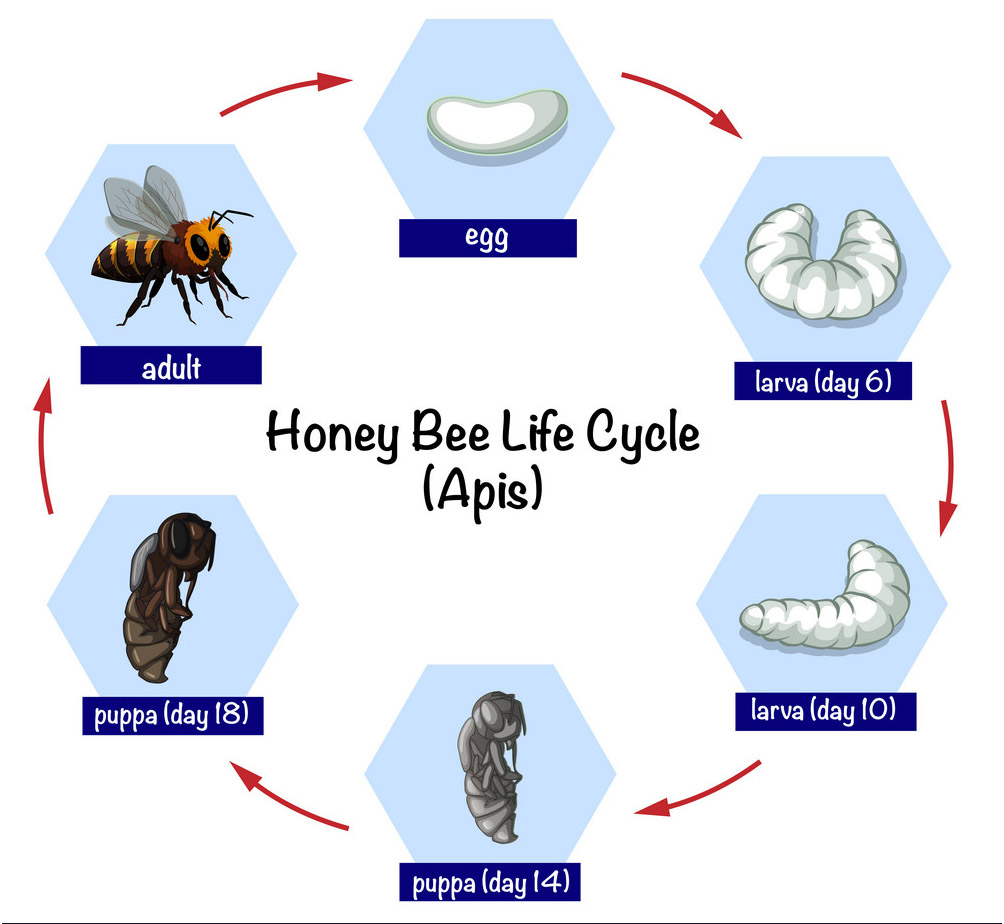
In this fascinating article, we will explore the enchanting world of bees, specifically focusing on their incredible journey from egg to larva. Discover the intricate process of metamorphosis these tiny creatures undergo and gain a deeper understanding of the magical transformation that takes place within the hidden confines of a beehive. Join us as we unravel the mysteries of bee beginnings and witness the awe-inspiring beauty of nature’s intricate design.
Introduction to the Bee Life Cycle
The life cycle of a bee is truly a remarkable process that showcases the wonders of nature. From the moment an egg is laid by the queen bee to the emergence of an adult bee, there are several stages of growth and development that take place. Each stage is significant and contributes to the overall functioning of the hive. In this comprehensive article, we will explore each stage of the bee life cycle, including the egg, larva, pupa, and adult bee, and delve into the intricate details of their transformation.
The First Stage: Egg
Overview of the Egg Stage
The first stage in the life cycle of a bee is the egg stage. It all begins when the queen bee lays an egg. These eggs are incredibly small, about the size of a grain of rice, and are carefully placed in individual cells within the honeycomb. The fate of each egg is determined by the queen bee, who controls whether it will develop into a worker bee, drone, or potential queen.
Egg-Laying by the Queen Bee
The responsibility of egg-laying falls solely on the queen bee. She possesses a specialized organ called the ovaries, which allow her to produce and lay eggs. The queen bee has the ability to selectively fertilize the eggs, using stored sperm from her earlier mating flights. Fertilized eggs have the potential to become worker bees or future queens, while unfertilized eggs develop into drones.
The Appearance of Bee Eggs
Bee eggs have a unique appearance that distinguishes them from other types of eggs. They are pearly white and oblong-shaped, with one end narrower than the other. The surface of the egg is smooth and slightly translucent, allowing workers bees to easily detect any abnormalities or potential issues.
Egg Development Time
The development of bee eggs varies depending on the type of bee they will become. Worker bee eggs typically take three days to hatch, drone eggs take around three and a half days, while potential queen bee eggs take approximately four days. This variation in development time is due to the different diets each type of bee will require during their larval stage.
Protecting the Eggs
Eggs are delicate and vulnerable to various threats within the hive. To ensure the survival and well-being of the eggs, worker bees play a crucial role in protecting them. They diligently monitor the temperature and humidity levels within the hive, carefully tending to the eggs to provide them with optimal conditions for development. Additionally, worker bees also defend the eggs from potential predators, such as wasps or other insects, ensuring their safety throughout the egg stage.

The Second Stage: Larva
Overview of the Larva Stage
After the eggs hatch, they transition into the larval stage. Larvae are tiny, legless creatures that require constant care and nourishment to continue their development. This stage is characterized by rapid growth and the consumption of large quantities of food.
The Hatching Process
When the time comes for the eggs to hatch, worker bees create a small opening at the top of the cell, allowing the newborn larvae to emerge. They carefully remove the cap of the cell and clean the area before the larvae make their way out.
The Growth and Feeding of Larvae
Once newly hatched, the larvae are incredibly small and helpless. They rely entirely on the worker bees for sustenance. Worker bees produce a special substance called royal jelly, which serves as the primary food source for the larvae. This gelatinous substance is rich in proteins and other essential nutrients, providing the larvae with the necessary nourishment for growth.
Larval Instar Stages
During the larval stage, bees go through a process known as instar stages. The larva gradually grows and sheds its outer skin multiple times, each shedding marking the transition into a new instar stage. There are four instar stages in total, with each stage exhibiting distinct physical characteristics and nutritional requirements.
Larval Development Time
The duration of the larval stage varies depending on the type of bee. Worker bee larvae require approximately six days to fully develop, while drone larvae take slightly longer, needing around seven days. The development time for potential queen bee larvae is the longest, spanning around eight and a half days. This extended duration is due to the high nutritional content of royal jelly provided to potential queen bees, enabling their accelerated growth.
Larval Instar Stages
First Instar Larva
The first instar larva is the stage immediately following hatching from the egg. At this point, the larva is extremely small, barely visible to the naked eye. Their appearance is cylindrical and without any distinct physical features. First instar larvae rely on the worker bees to feed them royal jelly, which they consume voraciously to fuel their growth.
Second Instar Larva
As the larvae progress into the second instar stage, they undergo a significant growth spurt. They become larger and more robust, their bodies taking on a curved shape. At this stage, the larvae continue to receive ample amounts of royal jelly, supplemented by a combination of pollen and nectar brought into the hive by worker bees.
Third Instar Larva
In the third instar stage, the larvae experience another growth surge, becoming even larger and more robust. They develop distinct body segments and exhibit curled positions within their cells. At this point, the diet of the larvae shifts, and they begin to consume larger amounts of pollen and nectar, preparing for their final instar stage.
Final Instar Larva
The final instar larva is the last stage before the larvae transition into the pupal stage. At this stage, the larvae are fully developed and are about to undergo a remarkable transformation. They continue to feed voraciously, consuming copious amounts of pollen and nectar, storing up energy for the impending metamorphosis.

The Role of Worker Bees in Larval Care
Worker Bee Duties
Within the hive, worker bees play a critical role in the care and development of bee larvae. They tirelessly carry out a range of duties, ensuring the larvae receive the necessary care and attention. From feeding them with the appropriate food to maintaining optimal hive conditions, worker bees are the backbone of larval care.
Feeding the Larvae
One of the vital duties of worker bees is to feed the larvae. They do so by regurgitating and synthesizing royal jelly, a highly nutritious substance that meets the specific dietary needs of the larvae at each stage of development. The ability of worker bees to produce royal jelly and feed it to the larvae is crucial for their growth and overall health.
Nursing Behavior
Worker bees exhibit nurturing behavior towards the larvae. They carefully clean and groom the larvae, ensuring they are free from any debris or unwanted substances. This grooming behavior is not only hygienic but also allows the worker bees to inspect the larvae for any signs of disease or abnormalities.
Maintaining Temperature and Humidity
Worker bees maintain optimal temperature and humidity levels within the hive to create a conducive environment for larval development. They constantly regulate these conditions, using their wings to circulate air and maintain a consistent temperature. Temperature control is crucial during the larval stage, as it directly influences the growth and development of the larvae.
Cleaning and Grooming the Larvae
Worker bees are meticulous when it comes to the cleanliness of the larvae. They meticulously remove waste materials and debris from the cells, ensuring a clean and hygienic environment for the larvae to thrive. This cleaning behavior prevents the larvae from being subjected to harmful pathogens or bacteria, promoting their overall well-being.
The Third Stage: Pupa
Overview of the Pupal Stage
After the larval stage, the bees enter the pupal stage, which marks a significant transition in their development. During this stage, the bees undergo dramatic changes, both externally and internally. The pupal stage is characterized by the transformation of the larva into an adult bee.
Pupal Cell Creation
Before entering the pupal stage, worker bees create special cells within the honeycomb specifically designed for pupation. These cells are larger and have distinct vertical walls to accommodate the growing bee. Once inside the cell, the bees are fully enclosed and protected from external influences.
Pupal Metamorphosis
Metamorphosis is a pivotal process that takes place during the pupal stage. The larva inside the pupa undergoes a remarkable transformation, dissolving its existing tissue and reconstructing it into the body of an adult bee. During this time, the wings, legs, and other essential body parts develop, transforming the bee into its final form.
Development Inside the Pupa
While inside the pupa, the bee undergoes rapid growth and development. The cells within the pupa nourish and support the developing bee, providing essential nutrients for its transformation. This stage is critical in shaping the bee’s overall appearance and preparing it for life outside the honeycomb.
Duration of the Pupal Stage
The pupal stage varies in duration depending on the type of bee. It typically lasts for around 11 days for worker bees, 14 days for drones, and approximately 15 days for potential queen bees. This extended time for potential queen bees is due to their specialized diet of royal jelly during the larval stage, which enhances their growth and development.

The Fourth Stage: Adult Bee
The Emergence of the Adult Bee
The final stage in the bee life cycle is the emergence of the adult bee from the pupal cell. After completing their development inside the pupa, adult bees chew through the wax cap covering their cell and emerge into the world. This emergence marks a significant milestone as the bee transitions into its fully grown form.
Behavioral Changes
As adult bees emerge, they undergo a series of behavioral changes. They possess fully developed wings and antennae, allowing them to explore their surroundings and navigate the hive. Adult bees also develop the ability to collect nectar, pollen, and propolis, contributing to the overall functioning of the hive.
Mating and Reproduction
Upon reaching adulthood, drones seek out potential mates, while queen bees note their reproductive capabilities. Drones engage in mating flights, attempting to mate with a queen from another colony. For the queen bee, successful mating events allow her to store sperm in her spermatheca, ensuring she can lay fertilized eggs for the rest of her life.
Roles and Responsibilities in the Hive
As adult bees join the hive, they assume distinct roles and responsibilities. Worker bees take on various tasks such as foraging for food, cleaning the hive, and caring for the queen and her brood. Drones, on the other hand, focus solely on mating activities and providing an additional source of genetic diversity within the colony.
Lifespan of an Adult Bee
The lifespan of an adult bee varies significantly depending on the type of bee. Worker bees, whose lives revolve around the constant demands of the hive, typically live for around six weeks during the summer months. Drones have a much shorter lifespan, living for approximately eight weeks. Queen bees, with their critical role in the hive, can live up to several years, continually laying eggs and ensuring the survival of the colony.
Bee Beginnings: The Wonders of Transformation
The Fascinating Process of Bee Development
The life cycle of a bee is an awe-inspiring process that showcases the wonders of transformation in the natural world. From the humble beginning as an egg to the emergence of an adult bee, each stage in the bee life cycle is filled with intricate changes and growth. The remarkable ability of bees to transform themselves into such diverse and complex creatures highlights the beauty and complexity of nature.
Implications for Beekeeping
Understanding the bee life cycle is crucial for beekeepers. It allows them to have a deeper insight into the needs of the hive and ensure the well-being of the bees. By providing the appropriate care and support at each stage of development, beekeepers can contribute to the overall health and productivity of the colony.
Understanding the Bee Life Cycle
By delving into the different stages of the bee life cycle, we gain a profound understanding of the intricate processes that contribute to the survival and success of the hive. From the careful egg-laying by the queen bee to the nurturing behavior of worker bees and the metamorphosis of the pupa, each stage plays a vital role in the overall functioning of the colony.
The Importance of Bee Conservation
The bee life cycle is not only a testament to the wonders of nature but also highlights the critical role that bees play in our ecosystem. Bees are essential pollinators, facilitating the reproduction of numerous plant species. They contribute to the production of food crops and the overall biodiversity of our planet. Understanding and protecting their life cycle is crucial for the preservation and conservation of these remarkable creatures.
Conclusion
The life cycle of a bee is a fascinating journey filled with remarkable transformations and growth. From the tiny egg to the nurturing care during the larval stage, the delicate process of pupation, and the emergence of an adult bee, each stage is intricately connected and vital for the survival of the hive. The intricate details of the bee life cycle serve as a reminder of the incredible diversity and complexity of the natural world and the importance of preserving and understanding these magnificent creatures.
